Nader Asadi
Does Combining Parameter-efficient Modules Improve Few-shot Transfer Accuracy?
Feb 23, 2024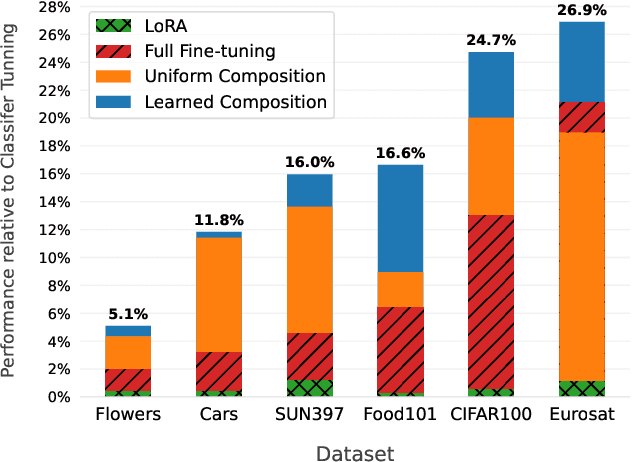
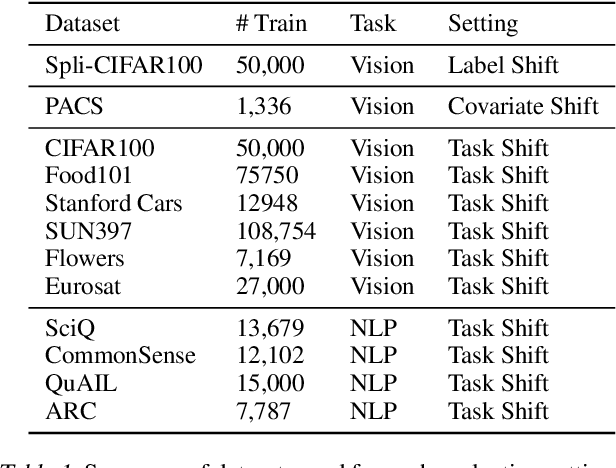


Abstract:Parameter-efficient fine-tuning stands as the standard for efficiently fine-tuning large language and vision models on downstream tasks. Specifically, the efficiency of low-rank adaptation has facilitated the creation and sharing of hundreds of custom LoRA modules, each trained on distinct data from various downstream tasks. In this paper, we explore the composability of LoRA modules, examining if combining these pre-trained modules enhances generalization to unseen downstream tasks. Our investigation involves evaluating two approaches: (a) uniform composition, involving averaging upstream LoRA modules with equal weights, and (b) learned composition, where we learn the weights for each upstream module and perform weighted averaging. Our experimental results on both vision and language models reveal that in few-shot settings, where only a limited number of samples are available for the downstream task, both uniform and learned composition methods result in better transfer accuracy; outperforming full fine-tuning and training a LoRA from scratch. Moreover, in full-shot settings, learned composition performs comparably to regular LoRA training with significantly fewer number of trainable parameters. Our research unveils the potential of uniform composition for enhancing transferability in low-shot settings, without introducing additional learnable parameters.
DFML: Decentralized Federated Mutual Learning
Feb 02, 2024Abstract:In the realm of real-world devices, centralized servers in Federated Learning (FL) present challenges including communication bottlenecks and susceptibility to a single point of failure. Additionally, contemporary devices inherently exhibit model and data heterogeneity. Existing work lacks a Decentralized FL (DFL) framework capable of accommodating such heterogeneity without imposing architectural restrictions or assuming the availability of public data. To address these issues, we propose a Decentralized Federated Mutual Learning (DFML) framework that is serverless, supports nonrestrictive heterogeneous models, and avoids reliance on public data. DFML effectively handles model and data heterogeneity through mutual learning, which distills knowledge between clients, and cyclically varying the amount of supervision and distillation signals. Extensive experimental results demonstrate consistent effectiveness of DFML in both convergence speed and global accuracy, outperforming prevalent baselines under various conditions. For example, with the CIFAR-100 dataset and 50 clients, DFML achieves a substantial increase of +17.20% and +19.95% in global accuracy under Independent and Identically Distributed (IID) and non-IID data shifts, respectively.
DAS: A Deformable Attention to Capture Salient Information in CNNs
Nov 20, 2023Abstract:Convolutional Neural Networks (CNNs) excel in local spatial pattern recognition. For many vision tasks, such as object recognition and segmentation, salient information is also present outside CNN's kernel boundaries. However, CNNs struggle in capturing such relevant information due to their confined receptive fields. Self-attention can improve a model's access to global information but increases computational overhead. We present a fast and simple fully convolutional method called DAS that helps focus attention on relevant information. It uses deformable convolutions for the location of pertinent image regions and separable convolutions for efficiency. DAS plugs into existing CNNs and propagates relevant information using a gating mechanism. Compared to the O(n^2) computational complexity of transformer-style attention, DAS is O(n). Our claim is that DAS's ability to pay increased attention to relevant features results in performance improvements when added to popular CNNs for Image Classification and Object Detection. For example, DAS yields an improvement on Stanford Dogs (4.47%), ImageNet (1.91%), and COCO AP (3.3%) with base ResNet50 backbone. This outperforms other CNN attention mechanisms while using similar or less FLOPs. Our code will be publicly available.
Prototype-Sample Relation Distillation: Towards Replay-Free Continual Learning
Mar 26, 2023



Abstract:In Continual learning (CL) balancing effective adaptation while combating catastrophic forgetting is a central challenge. Many of the recent best-performing methods utilize various forms of prior task data, e.g. a replay buffer, to tackle the catastrophic forgetting problem. Having access to previous task data can be restrictive in many real-world scenarios, for example when task data is sensitive or proprietary. To overcome the necessity of using previous tasks data, in this work, we start with strong representation learning methods that have been shown to be less prone to forgetting. We propose a holistic approach to jointly learn the representation and class prototypes while maintaining the relevance of old class prototypes and their embedded similarities. Specifically, samples are mapped to an embedding space where the representations are learned using a supervised contrastive loss. Class prototypes are evolved continually in the same latent space, enabling learning and prediction at any point. To continually adapt the prototypes without keeping any prior task data, we propose a novel distillation loss that constrains class prototypes to maintain relative similarities as compared to new task data. This method yields state-of-the-art performance in the task-incremental setting where we are able to outperform other methods that both use no data as well as approaches relying on large amounts of data. Our method is also shown to provide strong performance in the class-incremental setting without using any stored data points.
Probing Representation Forgetting in Supervised and Unsupervised Continual Learning
Apr 05, 2022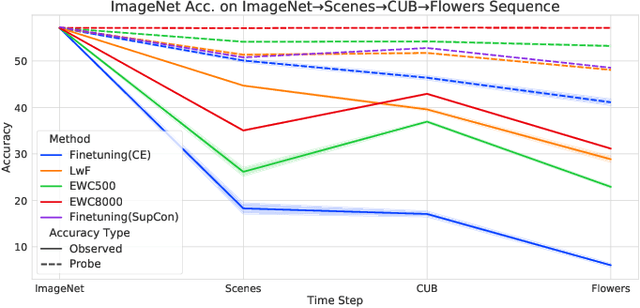

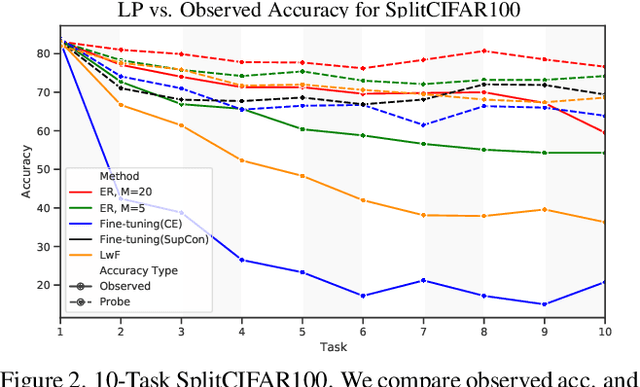
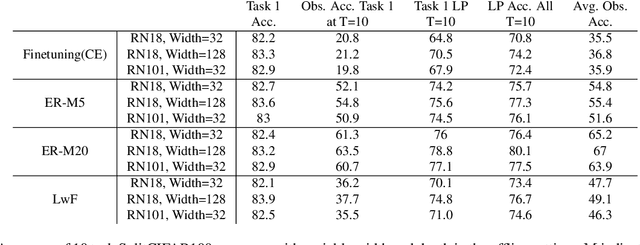
Abstract:Continual Learning research typically focuses on tackling the phenomenon of catastrophic forgetting in neural networks. Catastrophic forgetting is associated with an abrupt loss of knowledge previously learned by a model when the task, or more broadly the data distribution, being trained on changes. In supervised learning problems this forgetting, resulting from a change in the model's representation, is typically measured or observed by evaluating the decrease in old task performance. However, a model's representation can change without losing knowledge about prior tasks. In this work we consider the concept of representation forgetting, observed by using the difference in performance of an optimal linear classifier before and after a new task is introduced. Using this tool we revisit a number of standard continual learning benchmarks and observe that, through this lens, model representations trained without any explicit control for forgetting often experience small representation forgetting and can sometimes be comparable to methods which explicitly control for forgetting, especially in longer task sequences. We also show that representation forgetting can lead to new insights on the effect of model capacity and loss function used in continual learning. Based on our results, we show that a simple yet competitive approach is to learn representations continually with standard supervised contrastive learning while constructing prototypes of class samples when queried on old samples.
Tackling Online One-Class Incremental Learning by Removing Negative Contrasts
Mar 24, 2022


Abstract:Recent work studies the supervised online continual learning setting where a learner receives a stream of data whose class distribution changes over time. Distinct from other continual learning settings the learner is presented new samples only once and must distinguish between all seen classes. A number of successful methods in this setting focus on storing and replaying a subset of samples alongside incoming data in a computationally efficient manner. One recent proposal ER-AML achieved strong performance in this setting by applying an asymmetric loss based on contrastive learning to the incoming data and replayed data. However, a key ingredient of the proposed method is avoiding contrasts between incoming data and stored data, which makes it impractical for the setting where only one new class is introduced in each phase of the stream. In this work we adapt a recently proposed approach (\textit{BYOL}) from self-supervised learning to the supervised learning setting, unlocking the constraint on contrasts. We then show that supplementing this with additional regularization on class prototypes yields a new method that achieves strong performance in the one-class incremental learning setting and is competitive with the top performing methods in the multi-class incremental setting.
New Insights on Reducing Abrupt Representation Change in Online Continual Learning
Mar 08, 2022



Abstract:In the online continual learning paradigm, agents must learn from a changing distribution while respecting memory and compute constraints. Experience Replay (ER), where a small subset of past data is stored and replayed alongside new data, has emerged as a simple and effective learning strategy. In this work, we focus on the change in representations of observed data that arises when previously unobserved classes appear in the incoming data stream, and new classes must be distinguished from previous ones. We shed new light on this question by showing that applying ER causes the newly added classes' representations to overlap significantly with the previous classes, leading to highly disruptive parameter updates. Based on this empirical analysis, we propose a new method which mitigates this issue by shielding the learned representations from drastic adaptation to accommodate new classes. We show that using an asymmetric update rule pushes new classes to adapt to the older ones (rather than the reverse), which is more effective especially at task boundaries, where much of the forgetting typically occurs. Empirical results show significant gains over strong baselines on standard continual learning benchmarks
Towards Shape Biased Unsupervised Representation Learning for Domain Generalization
Sep 18, 2019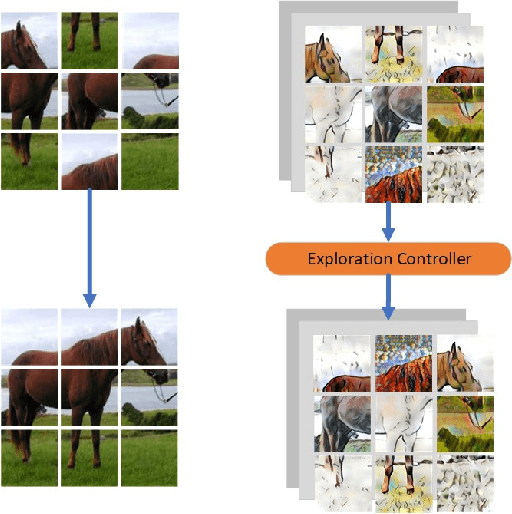
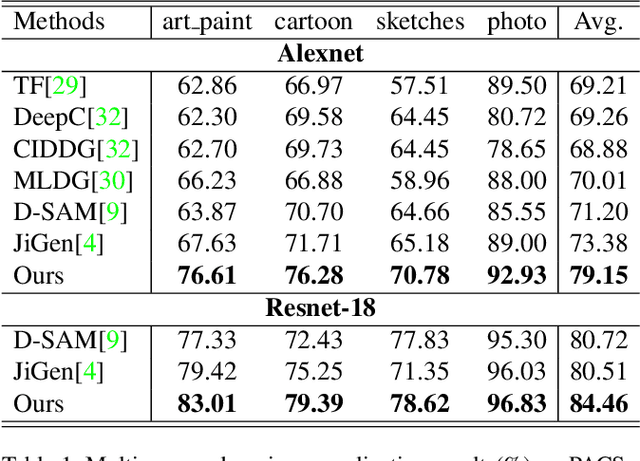

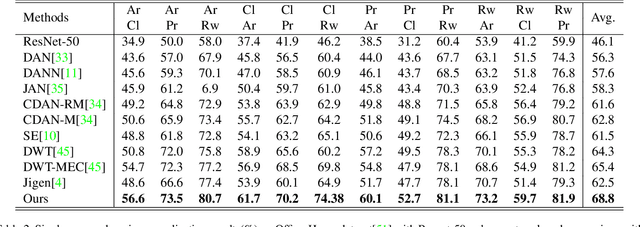
Abstract:It is known that, without awareness of the process, our brain appears to focus on the general shape of objects rather than superficial statistics of context. On the other hand, learning autonomously allows discovering invariant regularities which help generalization. In this work, we propose a learning framework to improve the shape bias property of self-supervised methods. Our method learns semantic and shape biased representations by integrating domain diversification and jigsaw puzzles. The first module enables the model to create a dynamic environment across arbitrary domains and provides a domain exploration vs. exploitation trade-off, while the second module allows the model to explore this environment autonomously. This universal framework does not require prior knowledge of the domain of interest. Extensive experiments are conducted on several domain generalization datasets, namely, PACS, Office-Home, VLCS, and Digits. We show that our framework outperforms state-of-the-art domain generalization methods by a large margin.
Diminishing the Effect of Adversarial Perturbations via Refining Feature Representation
Jul 01, 2019

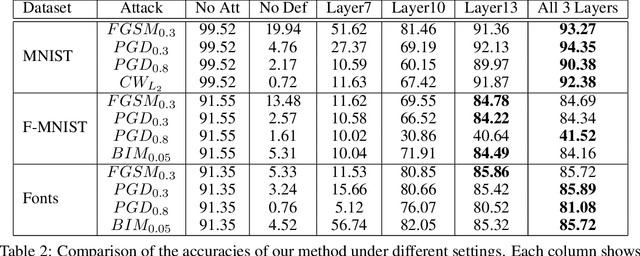

Abstract:Deep neural networks are highly vulnerable to adversarial examples, which imposes severe security issues for these state-of-the-art models. Many defense methods have been proposed to mitigate this problem. However, a lot of them depend on modification or additional training of the target model. In this work, we analytically investigate each layer representation of non-perturbed and perturbed images and show the effect of perturbations on each of these representations. Accordingly, a method based on whitening coloring transform is proposed in order to diminish the misrepresentation of any desirable layer caused by adversaries. Our method can be applied to any layer of any arbitrary model without the need of any modification or additional training. Due to the fact that full whitening of the layer representation is not easily differentiable, our proposed method is superbly robust against white-box attacks. Furthermore, we demonstrate the strength of our method against some state-of-the-art black-box attacks such as Carlini-Wagner L2 attack and we show that our method is able to defend against some non-constrained attacks.
 Add to Chrome
Add to Chrome Add to Firefox
Add to Firefox Add to Edge
Add to Edge